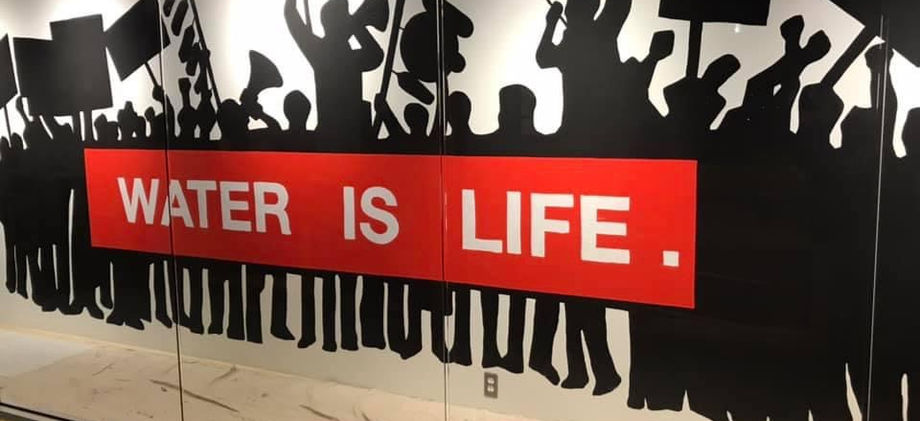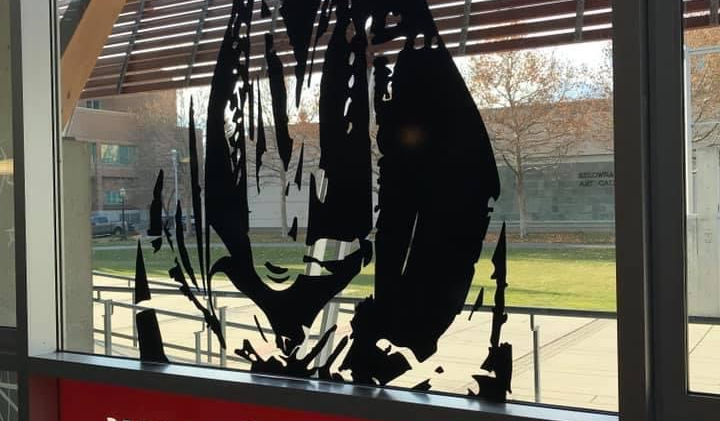Alternator Gallery Mural / Vinyl Murals
The winter of 2019 I installed a live mural directly onto the gallery's front window space that accompanied 5 large vinyl pieces that were installed in the front windows of the Kelowna Rotary Centre for the Arts to collectively create a solo exhibition based upon the sacredness of our siwɬkʷ (water). At a time when Water Protectors were protesting the Site C dam, the Trans Mountain pipeline, and DAPL I felt a responsibility to utilize my art as a political tool to protest and educate.
My partner Csetkwe Fortier assisted in the early stages of the painted mural. The spelling and translation of the nsyilxcen language was assisted by a handful of nation members. The spelling may differ from others but I did my best to write the words as best I could. If I made mistakes I do apologize.
ałi kwu_swiwi-numtax, ałi kwu_suknaqinx, ałi axa/ L/tmxwula/xw.
We Are Beautiful, We Are Okanagan, Because Our Land is Beautiful.
“The Okanagan Nation has accepted the unique responsibility bestowed upon us by the Creator to serve for all time as protectors of the lands and waters in our territories, so that all living things return to us regenerated. When we take care of the land and water, the land and water takes care of us. This is our law.”
Syilx Water Declaration excerpt
When we speak to the health and well being of our people, we speak to our responsibility to maintain the health and resiliency of the tmxʷ ulaxʷ (land) and the timxʷ (Four Food Chiefs). As our existence is intertwined and woven together with all other beings on this land, an alteration or destruction of this natural world will impact our direct relationship of living in harmony and balance. It is in this belief that we understand our inherant responsibility to protect the land and its waters.
As indigenous peoples have been suspended in a world that has been built upon the concept of the doctrine of discovery, this concept gives to the colonial powers the claim over lands that at the time of contact had already belonged to and had been governed over by sovereign nations. Under this concept the idea of land title was structured to unethically remove the lands from the sovereign nations who occupied it prior to first contact. Since its creation it has been utilized by the colonial governments and upheld by its unjust judicial system to unilaterally dispossess and invalidate the indigenous possession of the lands. By invalidating and falsely claiming that the indigenous peoples of these lands were inferior and lacked any such structure of governance in place, the settler colonials and their government were free to occupy lands and begin the fur trade. This began the industry of resource extraction from our lands. Since the first moment this has been known by our peoples as an unhealthy and unsustainable practice that in a short period of time (152 years) has irreparably altered and destroyed the natural ecosystems, biodiversity, and waterways that were striving prior to first contact. It is through the destruction of land and water that we begin to see the correlation of disease introduction and the declining population of the indigenous nations. This practice has been continued by the predecesors and has become a cornerstone of fuelling the Canadian economy through forest, gas, oil, and hydro extractions and for such reason has become a protected group of industries by the government. In the early years of the construction of Canada it was seen that in order to gain control of the rich cache of resources and exṕoit them to their fullest benefit, the Crown and the Canadian Government would have to deal with what has always been seen as “The Indian Problem”. As we had been deemed inferior and a “problem” to the progress of the newly formed colony of Canada, the governing bodies set out to address the problem by creating legislations and policies that would kill off, contain and assimilate us into the non indigenous populations. Through legislation such as the potlatch bans, the reserve systems, the residential school systems, the Indian Act, and the White Paper, the inability to retain legal councel to fight for our rights in the courts, and the inability or right to vote up until roughly 60 years ago, the government had sought to coral and/or absorb the indigenous peoples which would then allow for the further colonizing and exploiting of the lands without any opposition from the indigenous peoples.
An era of genocide by way of disconnecting the people from the language, the culture, and the lands, was implemented thus displacing them to open up industrial opportunities, from lands that did not belong to the governments or industries. After years of being metaphorically and literally handcuffed from fighting for our rights and our lands we now enter into the time where indigenous peoples are challenging the colonial judicial system and confirming what we always knew to be true. We have Title and Rights to the lands in our unneeded territories. BC being a hot bed for pipelines is in almost its entirety still legally unceded. There were no wars that were lost by the indigenous people in which land would have not been conquered, there were no treaties signed, and there were no agreements (up until recently with a select few Nations) that would have constituted the transfer of land title from indigenous peoples. The majority of BC is unceded and as such a number of court rulings have outlined that Title and Rights exists prior to contact.
Calder v British Columbia (AG) [1973] SCR 313, [1973] 4 WWR 1
In Calder v British Columbia (AG), the Supreme Court recognized that Aboriginal title to land was based in "historic occupation and possession" of their traditional territories and "does not depend on treaty, executive order or legislative enactment."
[T]he fact is that when the settlers came, the Indians were there, organized in societies and occupying the land as their forefathers had done for centuries. This is what Indian title means...
— Calder v British Columbia (AG)[11]
Delgamuukw v British Columbia, [1997] 3 SCR 1010
Known as Delgamuukw v The Queen, is a ruling by the Supreme Court of Canada that contains its first comprehensive account of Aboriginal title (a distinct kind of Aboriginal right) in Canada.[1] In this decision, the Court went on to describe the "nature and scope" of the protection given to Aboriginal title under section 35 of the Constitution Act, 1982.
Haida Nation v British Columbia (Minister of Forests), [2004] 3 S.C.R. 511
is the leading decision of the Supreme Court of Canada on the Crown duty to consult Aboriginal groups prior to exploiting lands to which they may have claims. Chief Justice McLachlin, writing for a unanimous court, found that the Crown has a "duty to consult with Aboriginal peoples and accommodate their interests".[1] This duty is grounded in the honour of the Crown, and applies even where title has not been proven.
Tsilhqot’in Nation v. British Columbia, 2014 SCC 44
In a watershed decision released today, the Supreme Court of Canada (“SCC”) allowed the Tsilhqot’in Nation’s appeal and, for the first time in Canadian history, granted a declaration of Aboriginal title. In doing so, the Court confirmed that the doctrine of terra nullius (that no one owned the land prior to Europeans asserting sovereignty) has never applied to Canada, affirmed the territorial nature of Aboriginal title, and rejected the legal test advanced by Canada and the provinces based on “small spots” or site-specific occupation. The SCC overturned the Court of Appeal’s prior ruling that proof of Aboriginal title requires intensive use of definite tracts of land and it also granted a declaration that British Columbia breached its duty to consult the Tsilhqot’in with regard to its forestry authorizations. This case significantly alters the legal landscape in Canada relating to land and resource entitlements and their governance.
Although we have seen rulings handed down from the many court cases that outline that Aboriginal Title and Rights exists, there is a duty of the Crown to uphold its honour and attain free prior and informed consent from these Nations prior to, we still find ourselves on the front lines fighting for justice. Fighting to keep our way of life in tact and our connections to the land strong. Fighting to uphold the judicial decisions made. The recent decisions surrounding the governments endorsement of oil and gas pipelines has placed us in an all to familiar place of standing up for our inherant Title and Rights yet again. The difference now is that the rights we stand for is not just our aboriginal rights but the human right to clean water. As the pipe lines criss cross the provinces they some how in most cases cross through Indian Reserve lands? As the reserve system was created and land allocated to non indigenous peoples the indigenous peoples were left with only 2% land holdings of the entire country that make up the reserves in Canada and yet the pipelines find their way into our backyards, our water ways. As the Canadian government has endorsed the industry growth to support its economy it seems to have chosen to not adhere to the court rulings that outline the need for deep consultation with the indigenous peoples as the lands and water ways they cross are subject to Aboriginal Title and Rights. It is these blatant actions of ignoring the voice of the indigenous peoples who are simply asking that justice be upheld that have sparked the peoples of not just the indigenous communities but allies from diverse cultural backgrounds, to stand and fight for the justice that is needed, the justice that we as indigenous peoples have always had to fight for. The means in which we fight has shifted over the generations and today we find our battle grounds being much different and the weapons in which we fight have also morphed into something new. Today we fight in court rooms, with protest front lines, at pipeline and mining sites, in the media, and the weapons we now carry are protest signs, sage and tobacco bundles, lawyers. The time of the armed struggles have seemingly passed such as Wounded Knee, Oka, Gustafson Lake, but the spirit and energy is still carried by those who take to the front lines.
Grand Chief Stewart Phillip accuses Justin Trudeau and Rachel Notley of brazenly ignoring First Nations rights
by Charlie Smith on April 16th, 2018 at 1:54 PM
After an Ottawa summit on Kinder Morgan's Trans Mountain pipeline, Trudeau and Notley insisted yesterday that the project will be completed.
In response, Grand Chief Stewart Phillip declared these comments show that the two politicians "continue to brazenly and arrogantly ignore First Nations rights".
"Making unilateral decisions about projects on unceded Indigenous territories is the exact opposite of reconciliation," Phillip said in a news release. "We confirm that our opposition is resolute, and we fully intend to stop this massively destructive pipeline from being built.”
"Bailing out Kinder Morgan so they can trample Indigenous title and rights makes a mockery of the Canadian pledge to respect the rights of Indigenous peoples," Chamberlin declared. "Canada has committed to implementing the recommendations of the United Nations Declaration on Indigenous Peoples (UNDRIP) and leaving proper restitution to First Nation peoples this late is unacceptable."
-excert from The Georgia Straight


























